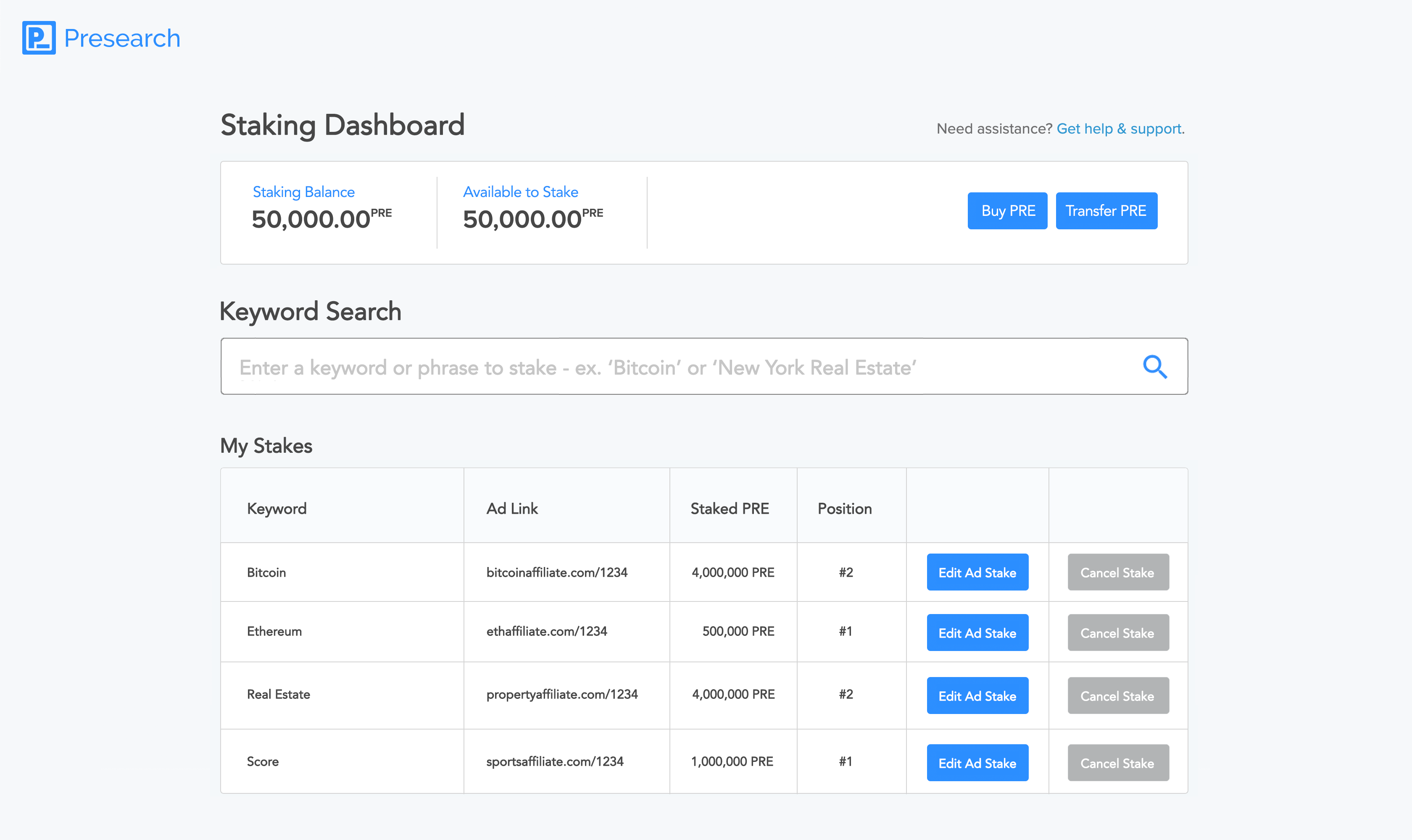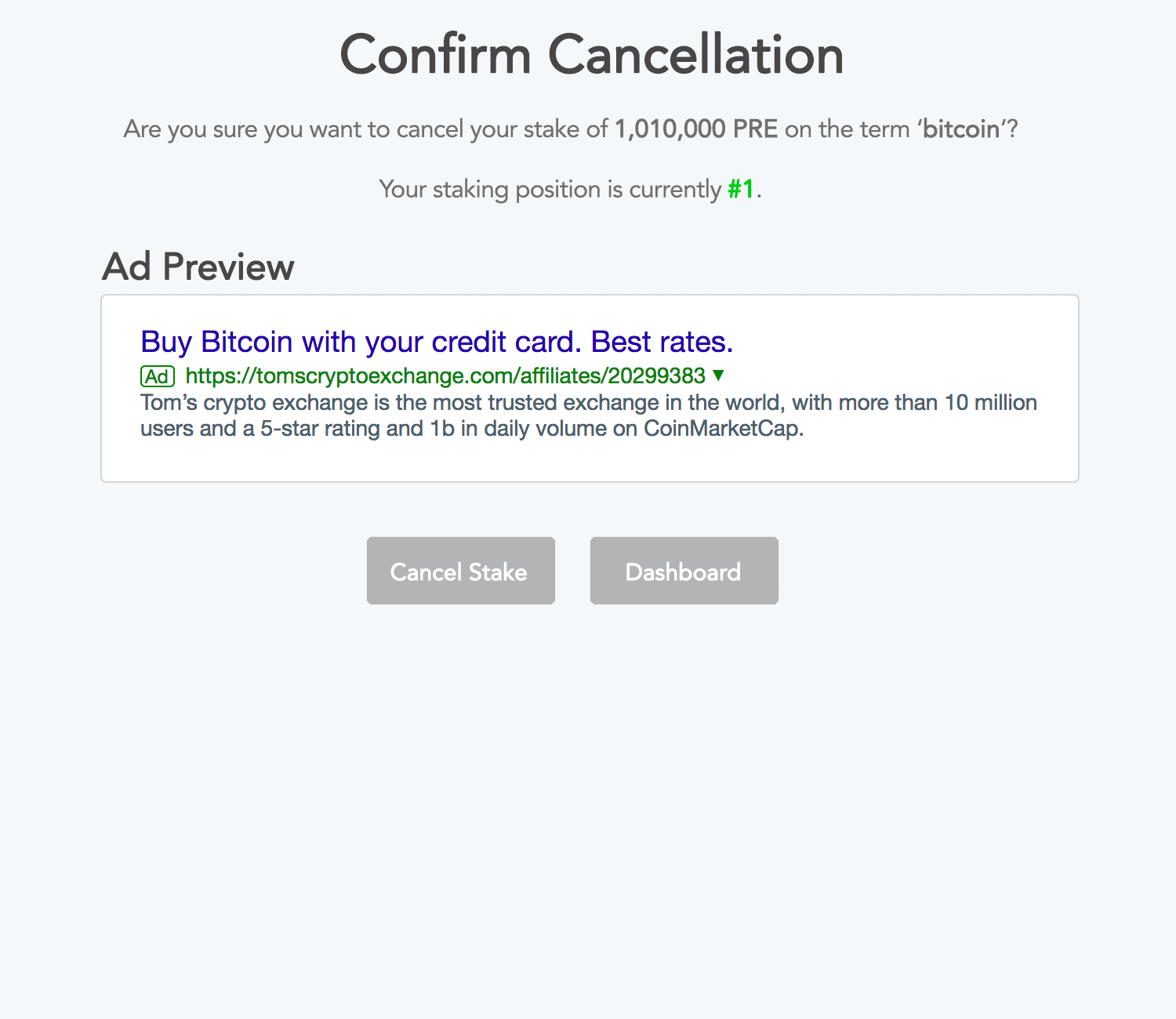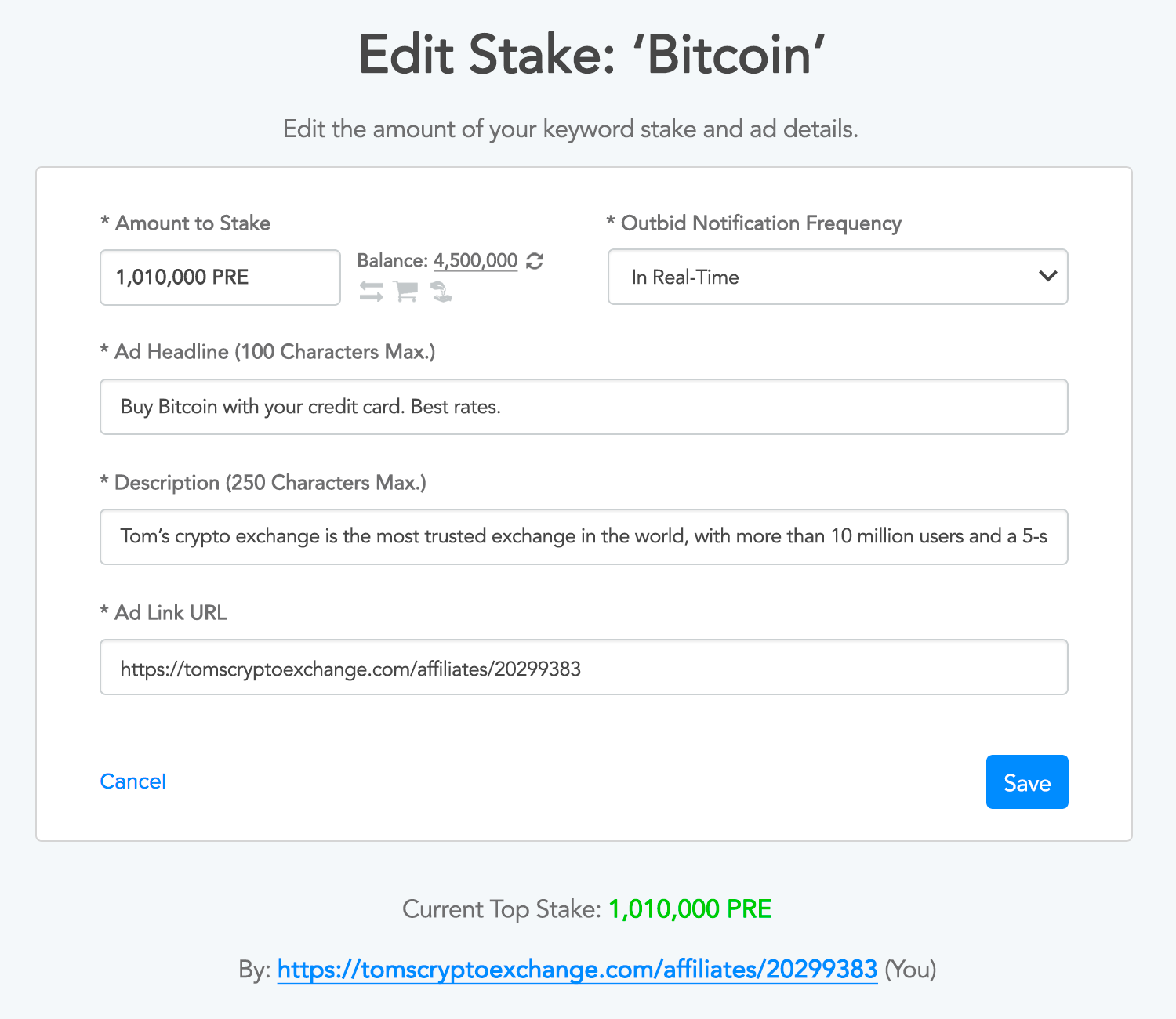| description |
|---|
If the objective is to put your PRE tokens to work, staking them against various keywords is a smart strategy. |
For the purpose of this post, we’re going to focus on the affiliate strategy as it is the simplest to explain, but the principles would be the same for an existing business.
The first step is familiarizing yourself with how the platform works and how affiliate marketing works.
After you have a basic understanding of keyword staking and how affiliates can benefit from traffic on Presearch, let’s get into a staking / traffic strategy discussion.
There are essentially two ways to approach the opportunity:
- You have some experience and knowledge of a certain industry, or know of an affiliate program that you’d like to find traffic for
- You’re going to find traffic opportunities and then look for affiliate programs to help you monetize the traffic
Either way, you need to identify keywords and prepare to stake them, but in the second approach, you’re going to spend more time sorting through affiliate offers to see if any match the potential keywords that you come up with.
In either case, you’re going to want to do as much keyword research as you can to identify terms that are relevant to the offer you want to provide.
For example, let’s say you’re familiar with the Binance affiliate program and know they pay out well.
So you are going to try to find traffic from people who are potential crypto traders.
You start brainstorming and you come up with the following terms:
- Binance
- Trade crypto
- Crypto exchange
- Buy Bitcoin
- Buy Ethereum
In addition to words you are familiar with, you can use external tools like WordTracker, KeywordTool.io, Wordstream, Moz or Ahrefs.
There are many guides to keyword research as well.
A really basic trick that works well for identifying the popularity of search terms is to just go to Google.com and when you start typing in the search field, you’ll see a list of suggestions. Those are usually the suggestions are the most-typed words.
Google Trends is another handy tool for discovering new and trending topics: https://trends.google.com/trends
As you start to compile your list of potential keywords, you’ll now want to head over to the Presearch Keyword Staking platform (released on January 29th, 2020) and research which words have already been staked and at which level.
Start your search here to discover which words have already been staked and create your own stakes
Above the search field you’ll see how many PRE you have available to stake, and you can buy additional PRE or transfer it into your staking account from your other Presearch wallets.
As you type a word to look up and stake, you’ll see a list of matching words. If it’s a word you’ve already staked, you’ll be able to edit it, otherwise you can stake a word using the ‘Stake This’ button.
Before you decide to stake a word, you should be aware of the information that’s provided on that screen.
The ‘Top Ad Link’ column displays the destination URL for the current top staked ad for that keyword. If there is no link (N/A), then it means no one else is staking that word yet.
The ‘Max Stake’ column shows the amount of PRE that the top staker has committed to that word. You will need to stake more than the top staker for your ad to be displayed. You are welcome to stake less, in case they remove their stake and then yours can display as a back up, but there are no guarantees you’ll receive any exposure for your ad.
The ‘Stakes’ column shows how many individual ads are staked against the indicated keyword, with more stakes meaning that it is a more competitive term.
As mentioned in the How Keyword Staking Works post, it’s important for you to understand how keywords are ranked.
The ranking factors associated with keyword staking may change in time, but at the launch of the platform this is the way things work:
A user types in a keyword or key phrase, let’s say it’s “Toronto Real Estate”.
The ad server will look to find any ads where the advertiser has used the exact term “Toronto Real Estate” as their trigger keyword.
It will then look to see how many PRE tokens are staked or locked to the keyword, and whichever advertiser has staked the most PRE will have their ad displayed.
Now, if there are no matches for the exact term “Toronto Real Estate”, it will break the phrase down into individual terms, so it will find ads with the keyword “Toronto” or “Real” or “Estate” and it will pick whichever ad has the most PRE tokens staked to it and display it.
Now that you know how to identify keywords and understanding how the staking platform and ad ranking system works, you’re ready to explore staking strategy
Your staking strategy will vary depending on whether you already have significant token holdings that you are looking to deploy, or if you don’t own many PRE yet and are looking for traffic with minimal cost to acquire tokens.
If you have a lot of PRE, and are less concerned with maximizing the traffic value of your tokens, you may wish to put a significant stake against a popular term like “Bitcoin”, “Ethereum” or other words where you have an interest and are able to find some ways to monetize through affiliate offers or simply want to send traffic to a worthy cause that you support.
In this case, you’re probably going to want to stake single word terms like “bitcoin”. If you staked that term, your ad would show up when someone searches for the exact term “bitcoin”, which is a very high-volume term.
Because you would also then show up for ‘fail over’ search terms, your ad would also show up when someone searches for “bitcoin ATM”, “bitcoin wallet”, “buy bitcoin”, “bitcoin price”, etc., as long as no one else is staking those terms.
For others who are just starting out, we’ll go into more detail about how to optimize traffic while minimizing the number of PRE required to achieve a top stake.
For example, let’s say you find an offer for bitcoin wallets that you really like. You’d love to stake the term “bitcoin”, but someone has already staked millions of PRE against it.
The really accurate term for the type of searcher you’re targeting is more specific anyway, so you identify “bitcoin wallet” and decide to stake more than the current leader so you can win that term.
You then also start looking for other terms that might not be staked yet, which you can get for the minimum amount, which is currently 100 PRE per term.
You go to Google and do some quick research, typing in “Bitcoin Wallet”.
It then suggests some other terms, “Bitcoin Wallet App”, “Bitcoin Wallet Online” and “Bitcoin Wallet Canada” that are relevant and which no one else is staking. You decide to stake those too.
Now, whenever someone searches for any of those terms, your ad will come up.
This might be a little confusing, and it may change in the future, but currently you would not show up for those terms just because you staked “Bitcoin Wallet” and that term is contained within the other suggestions we just listed above.
This is because if an ad’s staked keywords do not exactly match what the user searched for, it then defaults to looking at every single term as an individual keyword — in this example, “Bitcoin”, “Wallet” or “Canada”, and would display the ad associated with the term that has the largest stake.
In this case, it’s likely that the term “Bitcoin” has the highest stake, and so that ad would show. However, if the term “Canada” had the highest stake, the ad for the term “Canada” would show up.
This provides a million opportunities to try to stake terms for minimal PRE.
We’d suggest this as a general strategy:
Stake popular words that are not staked (ex. cars, computers, real estate, etc.) for small amounts to start with the expectation that you will eventually be outbid by someone focusing on those specific niches.
That will enable you to scoop up traffic for the broad terms, as well as the more specific multiple-word searches.
Then, once others start staking those keywords and squeeze you out of the top position, start looking for longer, more specific multiple word terms and do the same thing — small stakes to capture the top position and traffic, followed by either increasingly large stakes to defend your top position as needed, or expand out to longer, more specific terms as your shorter ones are taken by others.
We’ll go into this in more detail in a future post, but in the meantime, if you have questions, we suggest joining our Telegram community and asking questions to the admins and members there about how best to meet your traffic goals.
Once you’ve identified your words and your strategy, you’re going to go in and start staking terms.
You do this by accessing the Keyword Staking portal (released on January 29th, 2020) and searching for your words in the field provided.
On the results list that drops down below the search field, click on ‘Stake This’
next to the word of your choice.
You’ll then be taken to a screen that will show you who has the current highest stake amount (you can see the URL they are linking to) at the very bottom.
To outstake someone, you’ll need to increase the amount staked over the maximum by at least 100 PRE or 1% of the highest stake.
So if 1,000,000 PRE were staked against a term, you’d need to stake 1,010,000 to achieve the top position. You do this in the ‘Amount to Stake’ field on the form above. Then, enter your ad headline and URL (more on this later).
Finally, choose the outbid notification frequency from the drop down menu. The options are ‘Real-Time’, ‘Daily’ and ‘Weekly’. The shorter the notification window, the more notifications you’ll receive. You can adjust this at any time.
Once you’re satisfied with your stake, just hit the ‘Next’ button to lock it in and view your ad confirmation.
If you want to cancel a stake (to reallocate your PRE elsewhere, or if you made a mistake), just return to your dashboard and click the ‘Cancel Stake’ button.
Or you can click the ‘Edit Ad Stake’ button to display the ad details for editing.
That should give you enough information to get started.
We’re excited to introduce this amazing marketing opportunity to you and we look forward to seeing all the ways you’ll use the platform to get cheap / free traffic during the initial testing period.
The future of keyword research
Eventually, Presearch will develop its own tools for keyword exploration, but in the meantime, using external tools and estimating popularity based on general search activity is the best way to discover keywords to target.
** Note: This page contains affiliate links. This did not affect which services we’ve linked to, but we figured Presearch might as well earn from anyone who we introduce to the various services we’ve mentioned. **









